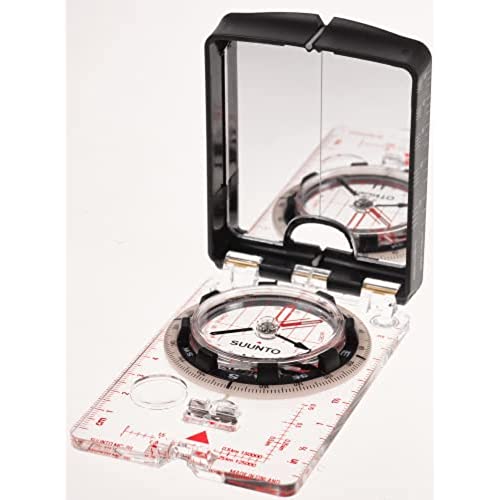
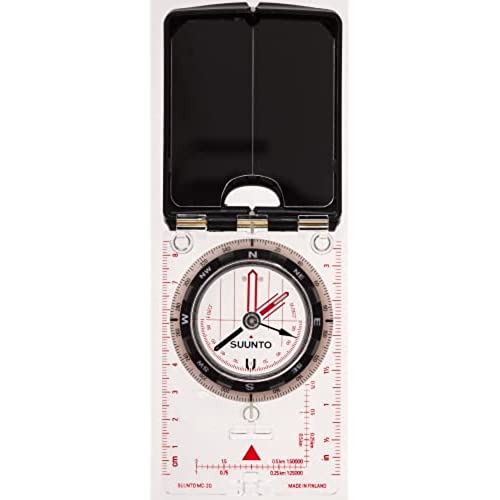
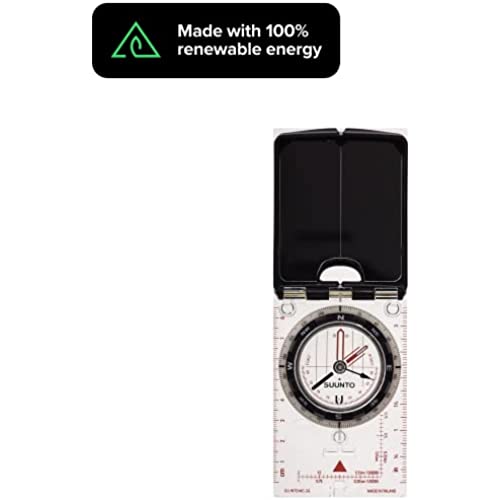
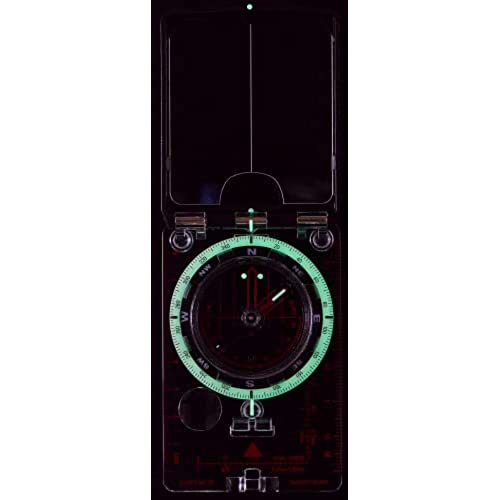
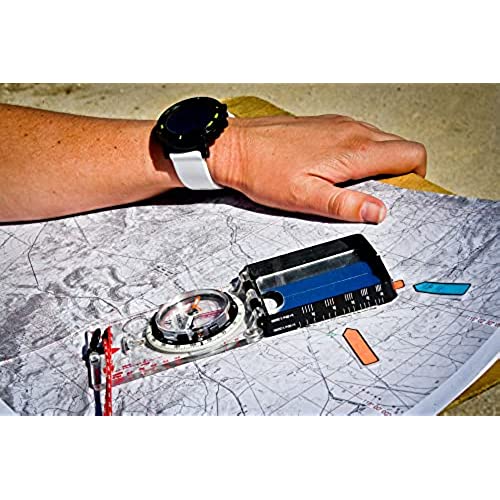
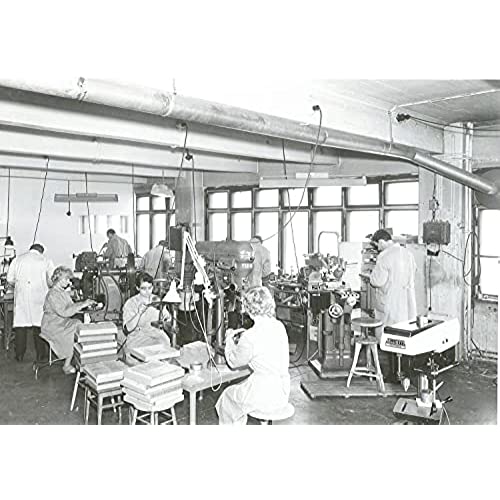
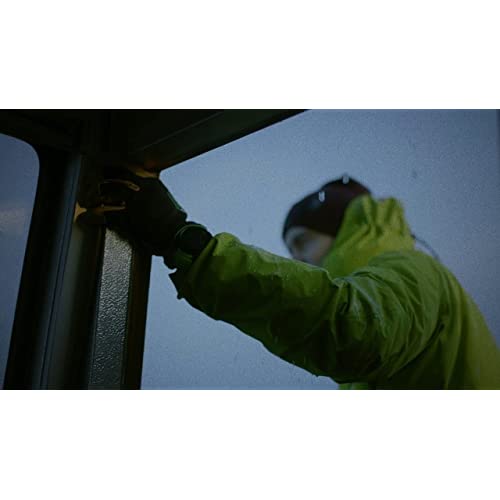







SUUNTO MC-2 Compass: Top-of-the-line compass for professionals & serious hikers
-

Estefania Weber
> 24 hourI almost returned this. Seemed totally useless for sighting landmarks on a bearing the first day I tried it. All it took was practice. Great product.
-

CaptainAJ
> 24 hourGreat compass overall! This compass is overkill with nice luxury features, but most importantly, it is a Suunto, which means you can bet your life on it. Suunto is one of few compasses that I trust. The MC-2G is nicer and more expensive than you really need to go in regards to a well-designed, functional compass you can trust. If you dont care about all the bells and whistles and the need for a Global needle (needle that is designed for both Northern and Southern hemispheres), you would do just fine with the Suunto M-3 for about half the price of the MC-2G, or perhaps the MC-2D/LIN coming in at under $50. But if youre ok dropping around $65-$70 on a base plate compass, you will not be disappointed with the MC-2G. I would like to note that I did not receive the MC-2GIn/USGS version with the 1:24k Romer scale, which was the version advertised in the listing. What I received was the metric version with the 1:25k and 1:50k Romer scales. If youre looking to purchase this compass, please be aware that there are three versions of this compass. Its helpful to know what you are purchasing, even though in my case I still received the wrong compass than what was advertised in the listing.The three versions of the MC-2G are as follows: 1) The metric version (SS004252010) with Romer scales are 1:25k and 1:50k. Centimeters listed along the left side of the compass, and inches broken down into 1/20th on the right side. This is the compass I received. 2) The USGS/Inch version (SS014891000.) with 1:24k Romer scale for use with 7.5 minute/1:24k USGS topo maps. This is the one I thought I was purchasing based on the listing. 3) The mils scale version (SS016326000). I havent frequently used 1:50k maps since my military days, but even though I received the wrong model of the MC-2G with 1:25k and 1:50k Romer scales, Im well-versed in land nav/using a map and compass, including MGRS, so the metric version is just fine and in no way impacts the overall functionality of the compass when using a 7.5 topo. Having the 1:25k and 1:50 Romers referenced vs. not having 1:24k Romer referenced on this particular model is not a huge issue and definitely not as important as knowing how to properly use a compass and map together. And since this metric version does have an inch ruler broken down into 1/20ths (nice feature) along the right side of the compass, you can still deal quite easily with a 7.5 minute topos based on 1-inch = 2,000 feet, which is the scale of a 1:24k/7.5 minute Topo map. There are a few cons Id like to point out based on initial use: 1) One of the rubber feet on the back of the base plate does not protrude like the other two. This must be a manufacturer defect. 2) Too much force is required to snap the lid shut, so much that I thought I would damage the the compass snapping the lid. Ill just close the compass when not in use, but will not snap the lid shut. 3) The plastic lanyard attachment is concerning. The design is flawed and doesnt give me warm fuzzies that the lanyard attachment will keep the compass attached to the lanyard in the long run. Ive decided not to use the lanyard attachment and instead have attached the lanyard directly to the compass with a larks head knot. Now I dont need to worry about the lanyard detaching from the compass. All in all, this compass was a great buy and I like it. Having the 1:24k Romer scale referenced would have been nice given I primarily use 7.5 topos for back country excursions, but the 1:24k scale is definitely not essential if youre familiar with land nav and using a map and compass. And for me, its not a big enough deal breaker and worth the hassle to return it for the USGS version. I still use an MGRS Coordinate Grid reader/plotter, which references several map scales, including 1:24k. So, receiving the metric vs. the USGS version of this compass isnt a deal breaker for me, but may be for a buyer who really just wants a compass designed for 7.5minute/1:24k USGS topo maps. If youre looking for a great compass with all the bells, whistles, and luxuries youll ever need, look no further than the MC-2G. However, be prepared to potentially deal with a few flaws like those Ive pointed out.
-

bikefaster
> 24 hourI bought a USGS Northern Hemisphere (NH) version a couple years ago and loved it so much I recently decided to buy another one, but chose the Global version this time. I did NOT like the Global version at all, because the needle got stuck, requiring me to repeatedly shake or tip the compass to get the needle to unstick and point north. With some research, I found that others have had the same problem. The needle on the global version has little vertical feet at both ends, where the clear plastic is bent up at 90 degrees, and these drag on the top side of the capsule a bit. Also, the black (south) end of the needle is much higher than the red (north) end. The whole needle is tilted down toward the red end. I returned the global version and got another norther hemisphere version and the NH version needle is very smooth and doesnt stick at all. I highly recommend the NH version, it is excellent. If I travel to the Southern Hemisphere I will get a dedicated SH compass rather than the global version.
-

The Veteran
> 24 hourPlease note that this compass is graduated in mils, and not in degrees. While there are 360 degrees in a circle, there are 6400 mils. Each degree is worth approximately 17.78 mils. Conversely, each mil is worth 0.05625 degrees. So you may have to do a little conversion work, depending on how you use your MC-2 compass. However, G-M angle information is given in mils as well as degrees, so you can simply use the declination adjustment in mils on your compass: if the GM angle is easterly, add the G-M angle to convert magnetic to grid azimuths; subtract the G-M angle to convert grid to magnetic. If the G-M angle is westerly, subtract the G-M angle to convert magnetic to grid, and add the G-M angle to convert grid to magnetic. A compass graduated in mils can offer greater accuracy in obtaining bearings--thats why the US Armys artillery units use mils--for greater accuracy. The compass is well-built. The global needle floats well anywhere in the world. The acrylic baseplate is great for computing grid azimuths when using a map. Once you set the declination adjustment to compensate for the G-M angle, no further math is necessary. You can see why the MC-2 Global compass is rated to highly--its made to the highest standards and its one of the most versatile compasses on the market. Even if you never travel to the Southern Hemisphere, the global needle will ensure smooth operation wherever you go.
-

Rob
> 24 hourGreat value for the money needle is sensitive and accurate all functions work when you read the instructions
-

Danny
> 24 hourWARNING!!! I ordered the MC-2 360/D/L/IN/NH compass, but received the MC-2 USGS compass. When I looked at the packaging, it is evident that someone put a MC-2 360/D/L/IN/NH sticker on the outside of the plastic packaging, over the original Suunto UPC/description for the MC-2 USGS label. (See photos below.) The only real differences are the scales printing on the baseplate. As I am in the US, I still like the USGS compass, but it is not exactly the compass I wanted. I contacted Amazon, and they started a free return of the USGS compass. On Amazons advice, I ordered the MC-2 360/D/L/IN/NH again. Well see what I get this time. The price dropped about $3, so that was good at least. UPDATE: Compass # 2 arrived - Still the incorrect MC-2 USGS compass!!!! :-( FINAL UPDATE: I love Amazon! I called customer service about receiving the wrong compass twice. They refunded both purchases fully, and told me to keep bot hot the compasses! I used this compass for a Wilderness survival class that had 3 navigation components and the compass worked beautifully. I dont have the exact baseplate scales I ordered, but this compass may actually be better. Again: YEA AMAZON!!! Also, the picture of the MC-2 360/D/L/IN/NH in this ad is not of the MC-2 360/D/L/IN/NH compass, but is a picture of the MC-2 Global compass. I bought this compass after returning a defective Silva Ranger, and a K&R Alpin, due to several issues. I like this compass better for a few reasons. This review is very long, but I did a thorough comparison of the three head to head. Executive summary - This compass is better than the Silva Ranger and much, much better than the K&R Alpin that costs twice as much. 1. Needle - Suunto is perfectly level, and highly visible, as it should be! The Silva needle was also very visible, but dipped down on the red side so much that just a 1/4 tilt of the baseplate caused it to bottom out. Thats why I returned it. The K&R needle was hard to see because the doghouse is a plastic notch on top of the compass dial, and the entire tip of the needle is encased in a plastic luminous material. In daylight, this made it tough to see, and at night, the needle tip didnt absorb enough light to make it glow enough. Double fail. 2. Luminous attributes - The Suunto luminous dial glows for 20 minutes or so after just a 10 seconds of exposure to my Princeton Tec Remix headlamp on the lowest setting. I can still easily read the numbers on the dial for about 10 minutes or so. The needle and north indicators luminous points are very easy to align, and hold a useable glow for about 30 minutes. The dots on the cover at the top and bottom at the aiming Vs are actually rods about 3/8 long of solid luminous material. This is nice because when you have the compass cover in position to use the mirror to take a bearing, the rods still absorb light from the top and glow nicely. 3. Declination/clinometer - The red numbers for the Suunto are printed so that they can be read from the back of the compass. This is good because the declination adjustment screw is on the reverse (and works nicely). Also, when using the clinometer, and finding an angle with the mirror as you are supposed to, the numbers are readable in the mirror. Brilliant! To be fair, the Silva is also printed on the reverse, just with black numbers, which are also easy to read. Also, the declination indicator pointer on the Suunto is very thin, and thus easier to set accurately, much more so than the wide black indicator on black hash marks on the Silva Ranger. To set the declination on the K&R, you turn the inner part of the compass face. This seems simple and great, until you realize that now the bearing pointer at the top of the compass no longer lines up with the numbers on the inner ring of the bezel ring, and the inner ring has no numbers. It can be very confusing getting the correct bearing because of this. I can imagine if I was tired, I would easily get the wrong bearing. 4. Mirror - The Suunto alignment guide down the middle of the mirror (to align your eye with the center of the compass) is wide enough to use, but not too wide to get in the way of getting your bearing. The Silva Ranger guide line was so thin I couldnt even see it. The K&R was a slit that blocked out the entire center of the compass, and even the needle itself near a 0* or 180* bearing. The Suunto and Silva mirror itself appears to be glass, and is like any other mirror in that it reflects very well, and projects a great flash for signaling. The K&R is metal, and thus unbreakable. It was not as bright for signaling, though. 5. Lanyard - The Suunto lanyard is woven with reflective material, and really reflects my headlamp light! It would be super easy to find this compass if you dropped it in the dark. A very nice feature indeed! I did not use the included plastic attachment thing on the Suunto, as I read it could fall off and you could lose your compass. I could easily see that. I just larks-headed it on. The Silva just had a plain red cord. Both had a little stainless steel flat screw to adjust the declination. The K&R lanyard was the most comfortable, and easily removable from the compass using the quick release buckle, but it flapped in a breeze, as a ribbon will do. Magnifier - I believe it is a 5x magnifier on the Suunto and the Silva, and a 6x on the K&R. All three compass magnifiers easily ignited my char cloth in the noon-day sun. Bezel ring - Besides being luminous, the bezel ring numbers are a slightly larger font on the Suunto. The Silva ring had more notches for your fingers, so it was a bit easier to grasp. The black ring, not being luminous, was impossible to see at night. The Suunto and Silva had numbers every 20*. This made it easy to know the 10* bearing in between as there was only one. Also, since the cardinal directions (N, NE, E, etc.) are printed on the on the black part of the Suunto ring, and the luminous part has numbers all the way around the ring (16 total numbers), with 4 numerical bearings between each of the main cardinal directions tick marks. (N, E, S, W) The K&R had numbers only every 30*, (just 8 total numbers) so there were two 10* bearings in between, plus the 4 cardinal direction letters. This made me double check myself more often, and seemed far less intuitive. The K&R was luminous, and smooth to turn, but maybe a tad too tight. Baseplate Feet - the K&R had 4 grippy feet in the corners. I made it a bit more stable when holding it down and drawing a line on your map. The Silva and Suunto have 3 trippy feet. This is still fine, but you just have to press on the center foot or the compass will rock a little bit. A very minor issue.. Final Tip - the Suunto cover snaps closed VERY tightly. It does loosen up a bit over time with use. Also, I found that if you put your thumb against the cover lip and rest it on the baseplate and sort of twist your thumb upwards, it acts to lever the lid open easily, vs. just pulling on the lid. My only gripe with the Suunto (and the reason for only 4 stars) is that the compass housing could be a tighter fit in the baseplate. It does move a bit side to side in the baseplate (maybe 1-2 degrees worth of slop). My work-around is to make sure the compass is firmly up at the top where the direction pointer is. My bearings are fine this way. If I could give this compass a 4.5 star rating, I would.
-

Vaajhmoob
> 24 hourFor example Amazon.com 1. They advertise as Suunto MC-2 But this Suunto MC-2 has many models with different CONFIGURATIONS and STYLEs and each one has its own part number, you have to high light the one you select to get the right part number and price to buy. They have those configurations and styles there, if you miss this step to select the one you want you will make a mistake See my photo #2 part number on box #3 that I selected and got the right one. 2. Mirror cover and base plate lock up too tight.... you are right but it is just the plastic ( the lighter color plastic ) on the cover that is a little plum- use the tip of a knife to shave a little out and it open and close finely. See picture#1 3. The unit works very well, you have to have map, use the compass N to find the N on earth, place the map to align N to match with the Compass N then ready for you to select your target area on paper map and then use your compass plate as a rule to draw a line from where you are as point A to your target as point B by this step you should know the direction of travel and the degree you will go then turn the ring to place that degree to line up with the red arrow on the base plate to the center line of the mirror that you will need to guide you while maintain MN arrow in the red N box that point to N. Turn your self to get that red arrow in box as said then travel the direction the painted arrow on the plate to to the degree on the ring and the mirror then walk by maintaining the MN in the box if you side step your direction the MN arrow will be out of the red N box turn yourself to put that MN arrow back in red N box to correct your direction and move on that is compass work... Remember that there will not have an arrow guiding you to your target...
-

Georgette Frami
> 24 hourThis compass is one of the best on the market for under $100. The sighting mirror is wonderful. Its very accurate and precise. It is also really easy to use for sightings. I passed my bearings certification exam with this compass. I highly recommend this model.
-

Heidi Buen
> 24 hourBought this for a birthday present for a outdoorsman and he loves it.
-

Benjamin J.
> 24 hourNo bubble in the lens. Actually made in finland. Only reason I gave 4 stars is that the bezel ring itself is not glow in the dark. The sighting marks, dots, etc do glow though. The needle is not as bright as the doghouse marks, but still visible. Comes with instruction booklet.
